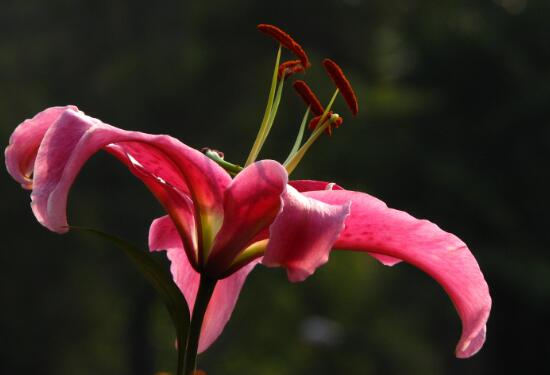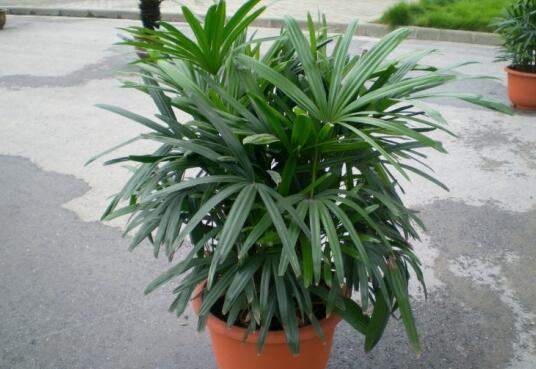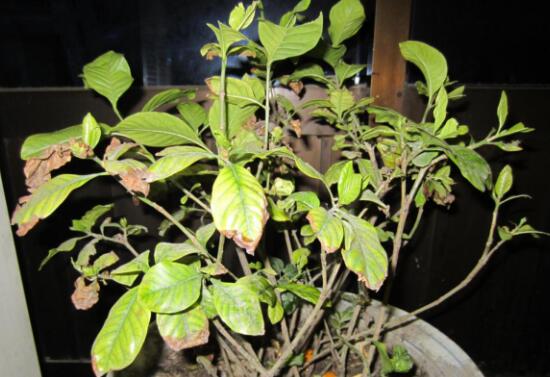Perfume lily leaves yellowing how to do, appropriate watering reasonable fertilization / pest spraying
Perfume lily, the queen of lilies, has beautiful flowers and rich colors, and is very ornamental at home. In life, there are many people who raise perfume lilies, but in the process of maintenance, many flower friends keep the leaves yellow, so what if the leaves of perfume lilies turn yellow? At this time, the flower friends calmly look for the cause, and then deal with it accordingly. Today, the editor will come to help you solve this problem.
First, perfume lily leaves yellowing, look for the cause

As a beautiful flower, perfume lily is a common indoor potted plant, but there are too many novice farmers, they do not have any breeding experience, so water will not be watered, fertilizer will not be applied, and all this will lead to the yellowing of perfume lily leaves, thus affecting the ornamental nature of the plant. In order to solve this problem, the editor summarized several reasons for the yellowing of the leaves of perfume lilies, and we moved on.
Second, the causes and solutions of yellowing of perfume lily leaves.
1. Environmental mutation
There are actually many reasons why the leaves of perfume lilies turn yellow, but we can first consider whether there is something wrong with the growing environment. Nowadays, the network is very developed, many flower friends' perfume lily potted plants are bought online, which may cause great changes in the environment, plants can not adapt for a while, resulting in leaf yellow symptoms.
The solution: it's simple to ask the store about the growth environment before the perfume lily, and then we change the environment at home until the perfume lily is fully adapted. After normal maintenance for a period of time, the leaves of the plant will recover.
2. Improper watering
Watering is a technical job, especially for beginners, watering perfume lilies, too much or less. Once too much watering, or lack of water, there will be perfume lily leaves yellowing symptoms.
① watered too much: the old leaves of perfume lilies did not change obviously, but the young leaves turned yellow. Solution: stop watering, move the pot to a ventilated sunny place, and let the water evaporate quickly; when seriously causing rotten roots, cut off the rotten roots, change the pot soil, and then replant.
② watering too little: the plant from bottom to top old leaves first yellow, if the lack of water for a little longer, it will be the whole plant yellow leaves, or even death. Solution: appropriate watering, with the basin soil moist, and then carefully maintained for a period of time, the leaves will recover.
3. Improper fertilization
After watering, let's talk about fertilization, which is also one of the reasons for the yellowing of perfume lily leaves. In the process of growth, perfume lilies need a lot of nutrients, but they avoid too much fertilizer, so it is not good to fertilize more or less.
① fertilizes too much: the young leaves of perfume lily are thick, shiny, and uneven. Solution: stop fertilizing, then irrigate to dilute the fertilizer, let the excess fertilizer out of the basin; in serious cases, cut the roots, change the soil, and replant.
② fertilization is too little: the young leaves and tender stems of the plant are yellow first. If it is not found in time, the yellow leaves of the whole plant will even die. Solution: apply the right amount of fertilizer to the perfume lily, but do not apply a large amount of thick fertilizer at one time, so as not to cause root burning.
4. Soil discomfort
In the culture method of perfume lily, it has been said that it likes deep soil layer, good drainage, and fertile slightly acidic soil. Once the soil is alkaline, it will lead to iron deficiency in perfume lilies, resulting in the phenomenon of yellow leaves. Features: young leaves are obvious, old leaves are lighter, mesophyll is yellow, leaf veins are green, and form a typical network.
Solution: if the above symptoms are caused by partial alkali in the soil, the flower friends can apply ferrous sulfate solution (7 parts of cake fertilizer, 5 parts of ferrous sulfate and 200 parts of water) to solve the problem.
5. Diseases and insect pests
In the process of breeding perfume lilies, due to improper maintenance and other reasons, the plant will inevitably get sick. Once diseases and insect pests are found, it is good to deal with them in time, but once they are not found in time, the leaves of perfume lilies will turn yellow.
Solution: first determine which kind of diseases and insect pests, and then spray to solve them. As for what medicine to spray, you can refer to the perfume lily pest control, which has a detailed introduction, interested flower friends can go to see.
Generally speaking, perfume lilies are easy to raise, but because many flower friends are novices, it is inevitable that there will be leaf yellow symptoms. However, after reading the full text, I believe you have a clear mind, the leaf yellow problem can be dealt with in accordance with the above method. With regard to the yellowing leaves of perfume lilies, the editor has introduced them here, hoping to give you some help.
What if the lily leaves turn yellow?
[FAQ] what if the lily leaves turn yellow?
[expert answer] cause analysis and treatment of yellowing of lily leaves:
The main results are as follows: 1. Too much watering leads to the yellowing of lily leaves: the young leaves are dark yellow and dull, the old leaves have no obvious change, the branches are small and yellow-green, and the new shoots are not long, indicating that they are overwatered.
Solution: put the flowers out of the pot in a ventilated, cool, self-drying soil mass and then put them back into the basin.
2. Long-term lack of water leads to the yellowing of lily leaves (dry yellow): the yellow of lack of water is different from the yellow of more water, the yellow of lack of water is withered and dry at the tip or edge of the leaf, and the old leaves wither and fall off from bottom to top, but the growth of new leaves is relatively normal.
Solution: pay attention to watering enough and thoroughly.
3. Exposure leads to yellowing (burning yellow) of lily leaves: strong sunlight shines directly on some flowers that like shade, which can easily cause withering of leaf tips and edges, and macula in the sunrise part of leaves.
Solution: just move to the shade.
4. Air drying leads to the yellowing of lily leaves: when the indoor air is too dry, some flowers that like the humid environment, such as hanging orchids and orchids, often appear leaf tip dryness or leaf edge scorching and so on.
Solution: water spraying, plastic film cover and other methods should be taken to increase air humidity.
5. The lack of sunlight leads to the yellowing of lily leaves (lack of light yellow): if the leaves are placed in a shady environment for a long time, the leaves do not get enough sunlight to form chlorophyll, and the whole leaves turn yellow and fall off.
Solution: be careful to move the flowerpot to the sunny place.
6. The low temperature leads to the yellowing of the lily leaves: the room temperature in winter is too low, and the flowers are often susceptible to cold damage, which leads to the yellowing of the leaves, withering and dying in serious cases. If the room temperature is too high, the transpiration of the plant is too high, and the root water and nutrients are in short supply, the leaves will turn yellow.
Solution: please pay attention to adjust the room temperature in time.
7. Excessive fertilization of lilies leads to yellowing of leaves (fat yellow): excessive fertilization will lead to the thickening of new leaves, and many rugged leaves, and the dry tips of old leaves will fall off.
Solution: stop fertilizing immediately, increase the amount of water, make the fertilizer flow out from the drainage hole at the bottom of the basin, or pour the basin immediately, rinse the soil block with water and then plant it back into the basin.
8. Lily leaves yellowed due to long-term lack of fertilizer: young leaves became pale, yellow or light green, while old leaves changed from green to yellow gradually.
Solution: check the basin soil, if there is a dry knot phenomenon should change the soil, usually apply thin fertilizer frequently and timely pour some alum water.
9, diseases and insect pests lead to lily leaves yellowing: leaf spot disease caused by fungi and other bacteria is easy to cause local necrosis of the leaves, yellow spots or patches appear, the whole leaves wither and fall off seriously, and the leaves are mottled with yellow and green after being infected by mosaic virus; suffering from shell insects, red spiders and other damage, the leaves will also become local yellow withered, or even the whole leaves will wither and fall off.
Solution: spray prevention and treatment in time.
[editor's comments] Lily sometimes appears the phenomenon of yellowing leaves, so what is the reason for this? The above first Agricultural Classic editor has introduced to you 9 causes of lily leaf yellowing and their solutions. For more information, you can also follow the relevant articles of our website planting technology channel. Thank you for your attention and support!
What about the yellowing of lily leaves? the reason for the yellowing of lily leaves
Lily, lily is a perennial herbaceous bulbous plant, what should we do when we encounter the yellowing leaves of lilies in the process of breeding? Next, let's talk about the reasons for the yellowing of lily leaves.
First, the water is yellow. Too much watering can easily cause long-term water in the basin soil, suffocating and rotting the roots, resulting in yellow leaves and even falling off; it is characterized by no obvious change in the old leaves and yellowing of the young leaves. Because the soil is too wet, the yellow leaves should stop watering, loosen the soil and let it ventilate and dry.
Second, dry and yellow. Due to lack of water and drought, it is characterized by the yellow of the old leaves from the bottom to the top. If the lack of water is a little longer, the whole plant will be yellow, or even die. It should be watered at the right time and adhere to the principle of "dry and wet, watering thoroughly".
Third, fat yellow. Caused by excessive fertilization or high concentration; characterized by thick, glossy, and uneven young leaves. Fertilizer, ploughing and watering should be controlled, and thin fertilizer should be applied once a week in summer. If you have applied too much fertilizer, you can pour more water to dilute and flush the fertilizer out of the soil.
Fourth, hungry yellow. During the growing period of potted lilies, long-term non-fertilization or insufficient fertilization will cause the phenomenon of leaf yellow. It is characterized by young leaves and tender stems first yellow. Lack of fertilizer also leads to the hardening of basin soil and the slender, yellow and tender branches. Fertilizer should be applied immediately and it will be effective within a week.
Fifth, partial fertilizer yellow leaves: lilies need more nitrogen and potassium fertilizer, and should be applied every 10-15 days during the growing period, while the supply of phosphate fertilizer should be limited, because too much phosphate fertilizer will cause the leaves to wither and yellow.
Sixth, iron deficiency yellow leaves. Lily is sensitive to soil lily salt, and the soil pH value is 5.5-6.5. The physiological diseases of iron deficiency and yellowing occurred in the alkaline conference. PH test paper can be used to monitor the pH value of fertilizer and water. Western drugstores and medical equipment are sold (2 yuan a copy, which can be used for a long time).
7. Leaf yellow during potting period: leaf yellow occurs most easily due to root injury and maladaptation to the new environment (basin soil, water quality, environmental humidity and temperature). At this time, leaf yellow should be protected, fertilized and watered dry and thoroughly, and the leaf surface should be sprayed with water. wait for the new leaves to grow and then maintain normally.
8. Diseases and insect pests: diseases and insect pests can also cause leaf yellowing. Get rid of diseases and insect pests in time.
- Prev

What if the brown bamboo leaves turn yellow, apply thin fertilizer frequently / control the amount of water / pay attention to shading
Brown bamboo is a highly ornamental plant, and keeping it at home also has many benefits for people, but in beautiful plants, if the leaves turn yellow, it will also affect its overall beauty. What if the brown bamboo leaves turn yellow? Next, the editor will take you to learn about it. First, what if the brown bamboo leaves turn yellow?
- Next

What about the yellowing of goose palm wood leaves, proper watering / rational fertilization / spraying of diseases and insect pests
Goose palm wood, a common indoor foliage plant, often appears on white-collar desks, it can be said that everyone has a pot. When facing the computer eyes swell, looking at the goose palm wood green lovely leaves, people will feel a lot of comfort. But once the yellow leaves appear, it will destroy all this! So, what if the leaves of goose palm wood turn yellow?
Related
- Fuxing push coffee new agricultural production and marketing class: lack of small-scale processing plants
- Jujube rice field leisure farm deep ploughing Yilan for five years to create a space for organic food and play
- Nongyu Farm-A trial of organic papaya for brave women with advanced technology
- Four points for attention in the prevention and control of diseases and insect pests of edible fungi
- How to add nutrient solution to Edible Fungi
- Is there any good way to control edible fungus mites?
- Open Inoculation Technology of Edible Fungi
- Is there any clever way to use fertilizer for edible fungus in winter?
- What agents are used to kill the pathogens of edible fungi in the mushroom shed?
- Rapid drying of Edible Fungi

